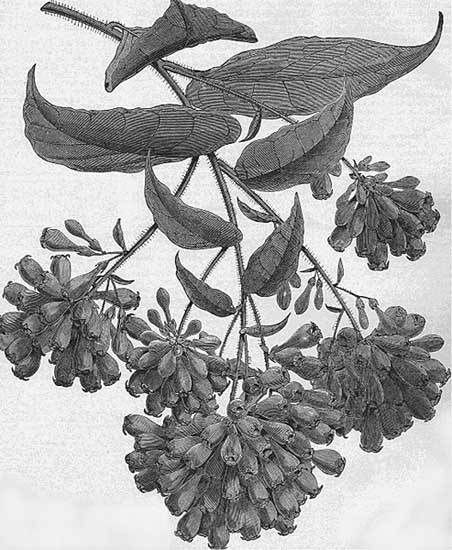
Synonymy
*Cestrum fasciculatum (Brongn. ex Neumann) Schldl., Linnaea 19: 261 (1846)
Habrothamus elegans Brongn. ex Neumann, Ann. Pomone 118 (1844).
T: not Australian; n.v.
Description
Shrub to 2.5 m high with soft, dense, simple hairs especially in axes and young parts, glabrous with age and the stems often purplish.
Leaves ovate, 4–13 cm long, 2-6 cm wide, rounded at base, entire, acuminate at apex, covered on both surfaces with moderately dense simple hairs; petiole 5-15 mm long.
Inflorescence 5–10-flowered, in terminal clusters or racemes; flowers purplish red, bracteate; calyx often reddish, usually 5-lobed, 7–9 mm long, with ciliate lobes joined above half way, not increasing in fruit; corolla tube 15–25 mm long, glabrous; lobes 3-5 mm long, pubescent externally with simple eglandular hairs, glabrous internally; stamens 5, equal, inserted just below halfway in the tube, included; filaments 7-8 mm long, widened and sparingly pubescent at base, glabrous above; style 15-20 mm long, glabrous; ovary glabrous.
Fruit 9-12 mm long, 6-8 mm wide, black or maroon, sometimes reported as red with white-spongy inside (Jepson manual) ; seeds 6-12 per fruit, 2.5–4 mm long, dark brown.
Description based primarily on collection P. Opie 125 (AD). [RMB]
Distribution and ecology
Reported as naturalised in waste places in NSW and in NW Tas. Native of Mexico.
Common name
Red cestrum
Notes
C. fasciculatum and C. elegans are similar in appearance, the usual difference being cited as C. fasciculatum having larger flowers. C. elegans also tends to have flowers which are in the "pink" range while C. fasciculatum flowers are usually described as being scarlet.
The outer surface of the calyx and corolla is also cited as being pubescent in C. fasciculatum but glabrous in C. elegans.
However C. fasciculatum cultivar "Newellii" (also as C. Newellii) is considered to be a hybrid between C. fasciculatum and C. elegans, most horticultural sources citing it as having glabrous corollas; true distinctions are unclear. This is probably why no distinction is made between C. fasciculatum and C. elegans on a New Zealand weed website at http://www.weedbusters.org.nz/weed_info/detail.asp?WeedID=83
Specimens seen in Australian herbaria are not consistent with respect to the hairiness of the calyx and corolla and so further investigation of these two species is needed before we can be sure just what is present in Australia [rmb Aug. 2006].
Derivation of epithet
From fasciculatum, Latin for bundled, presumably a reference to the grouping of the flowers.
Images and information on web
Information about this species and C. elegans as weeds in in New Zealand can be seen on their Weedbusters site at http://weedbusters.co.nz/weed_info/detail.asp?WeedID=83
A series of images of C. fasciculatum can be seen on the Weeds of Mexico site at www.conabio.gob.mx/malezasdemexico/solanaceae/cestrum-fasciculatum/fichas/pagina1.htm
Further information about the toxic properties of this plant can be found with a search in the FDA Poisonous Plant Database